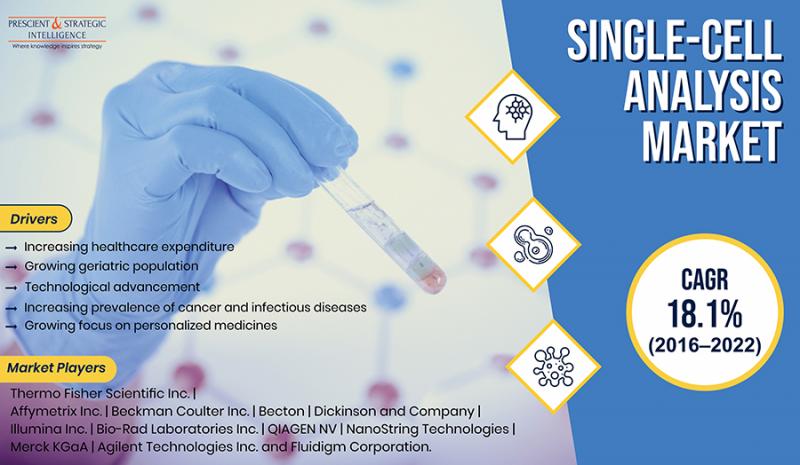The healthcare industry has taken several leaps and bounds when it comes to disease cures. Several diseases that killed millions of people some years back can now be cured completely by taking proper medication. But, in order to achieve this, the healthcare industry depends heavily on research & development (R&D) activities, which are forever ongoing. However, even after years of research and despite increasing innovations, various diseases exist that cannot be cured; cancer being the most common example.
Under this scenario, researchers need to look for different and innovative solutions, and one such emerging solution is single-cell analysis. It is due to all these factors that the global single-cell analysis market is predicted to witness an 18.1% CAGR during 2016–2022.
What Exactly Is Single-Cell Analysis?
It was assumed that each cell type in living tissues has a distinct function and lineage. Recent evidence and studies, however, have proved these assumptions incorrect, and it has been discovered that while cells may be identical, genetically and morphologically, they are actually heterogeneous and made up of cells which differ from each other. These revelations have been made by studying single cells.

It has further been observed that these differences among cells can have significant consequences when it comes to the health of the population as a whole. Single-cell analysis enables the study of cell-to-cell diversification within a cell population, i.e. cell culture, tissue, and organ. Single-cell analysis is the only way to study physiological functions in adults and embryos, which, in turn, can aid in the study of drug development and diseases.
Techniques for Single-Cell Analysis
- Flow Cytometry: This method is utilized for analyzing the expression of intercellular molecules and cell surfaces, defining and characterizing various cell types in a heterogeneous population of cells, evaluating the purity of isolated subpopulations, and examining the volume and size of cells. Flow cemetery enables simultaneous multi-parameter single-cell analysis.
- Next-Generation Sequencing (NGS): NGS includes a number of techniques and technologies, such as region-specific panel sequencing, whole-genome sequencing, and exome sequencing that enable researchers to sequence strands of ribonucleic acid (RNA) and deoxyribonucleic acid (DNA). The process is utilized for studying genes or individual sections and then identifying the sections of genomes that contribute to biological characteristics or diseases
- Polymerase Chain Reaction (PCR): This technique is utilized for analyzing short sequences of DNA or RNA and reproducing selected sections of RNA or DNA. While, before the cloning of DNA took weeks, with PCR, the process can be completed in a test tube in just a few hours. PCR is primarily performed for diagnosing genetic diseases, DNA fingerprinting, studying human evolution, establishing biological or paternity relationships, and finding viruses and bacteria.
- Microscopy: Also known as light microscopy, microscopy is the technical field of utilizing microscopes for viewing samples which cannot be seen with the unaided eye. This method is utilized widely across research centers and other healthcare facilities.
All of these techniques are used by cell banks & in vitro fertilization centers, academic & research institutes, hospitals & diagnostic laboratories, and biotechnology & biopharmaceutical companies. Among all these, hospitals and diagnostic laboratories make the most use of single-cell analysis techniques, for both research and diagnostic applications.
Clinical Applications of Single-Cell Analysis
In terms of research, single-cell analysis is widely being utilized in the fields of stem cells, cancer, neurology, immunology, and tissue regeneration. Cancer research is one of the key applications of this technology, since the number of cancer patients across the globe has been rising rapidly. These days, a few types of cancer can be managed and even treated, all thanks to R&D activities. But the fact remains that cancer is till affecting millions of people and the need for a proper cure has not diminished.
Single-cell analysis methods have provided important and powerful tools to get a deeper insight into intratumor heterogeneity, thereby enabling the targeting of therapy at clones that are most malignant. The technology can further be utilized for calculating a diversity index for different cancer patients, with this data further having the potential to be used for predicting poor response to chemotherapy and poor survival. In addition to this, single-cell analysis could also aid in the early detection of tumor cells in bodily fluids, including blood, sputum, and urine.
Apart from cancer, single-cell analysis is also being utilized for in vitro fertilization (IVF) and pre-implantation genetic diagnosis (PGD). The latter process includes the collection of single-cell from a blastomere set, for DNA single-cell sequencing. The aim of this process is to screen for genetic diseases, before implantation into the uterus.
The utilization of single-cell analysis can further pave the way for personalized medicine, which is developed to provide specific treatments suited to the needs of the individual. Patients suffering from rare diseases will benefit immensely from the development of personalized medicine.
In conclusion, single-cell analysis is an emerging technology that can have major applications in early disease diagnosis and can also be the key to finding treatments for various incurable diseases. Since the domain largely depends on R&D activities, it is necessary that the required funding is provided by organizations.
Author Bio
Sachin has around 7 years of experience in market research and consulting services for the healthcare industry. He holds varied experience in market sizing and forecasting with varied models, competition landscape, consumer behavior analysis, opportunity analysis, product/company benchmarking, data mining, and others.
He has successfully delivered multiple projects on go-to-market strategies, pricing strategy, price point analysis, Business Expansion, market-entry, and exit, share analysis, and others. Prior to joining P&S Intelligence, he worked with different research companies, including Transparency Market Research and MarketsandMarkets Pvt Ltd.
Some of the projects delivered by him include Scar Treatment Market, Skin Replacement and Substitutes Market, and Energy-Based Aesthetic Devices Market.





Leave A Comment